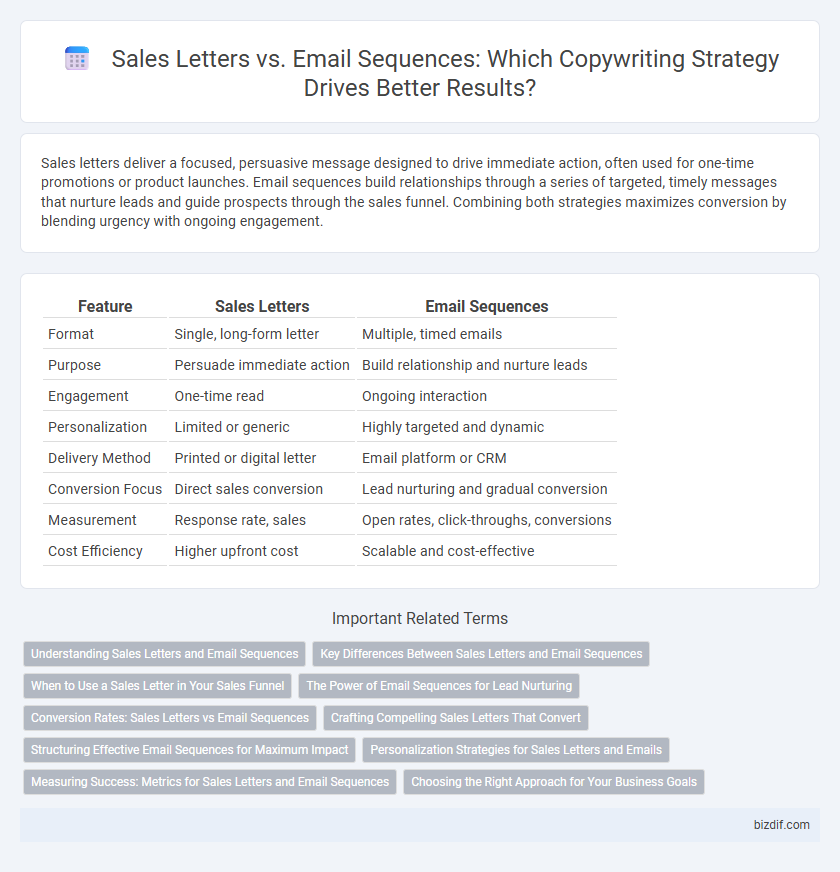Sales letters deliver a focused, persuasive message designed to drive immediate action, often used for one-time promotions or product launches. Email sequences build relationships through a series of targeted, timely messages that nurture leads and guide prospects through the sales funnel. Combining both strategies maximizes conversion by blending urgency with ongoing engagement.
Table of Comparison
| Feature | Sales Letters | Email Sequences |
|---|---|---|
| Format | Single, long-form letter | Multiple, timed emails |
| Purpose | Persuade immediate action | Build relationship and nurture leads |
| Engagement | One-time read | Ongoing interaction |
| Personalization | Limited or generic | Highly targeted and dynamic |
| Delivery Method | Printed or digital letter | Email platform or CRM |
| Conversion Focus | Direct sales conversion | Lead nurturing and gradual conversion |
| Measurement | Response rate, sales | Open rates, click-throughs, conversions |
| Cost Efficiency | Higher upfront cost | Scalable and cost-effective |
Understanding Sales Letters and Email Sequences
Sales letters are carefully crafted, standalone documents designed to persuade potential customers through compelling storytelling and clear calls to action, often used in direct mail and digital marketing campaigns. Email sequences consist of a series of timed, automated messages that nurture leads by delivering value, building trust, and guiding recipients through the sales funnel. Understanding the distinct structure and purpose of sales letters versus email sequences is essential for optimizing conversion rates and tailoring communication strategies effectively.
Key Differences Between Sales Letters and Email Sequences
Sales letters are typically standalone, highly persuasive documents designed to drive immediate action, often structured with a strong call-to-action and emotional triggers. Email sequences consist of a series of strategically timed messages aimed at nurturing leads, building relationships, and gradually guiding prospects toward conversion. The key difference lies in sales letters focusing on a single, impactful communication, whereas email sequences rely on sustained engagement through multiple touchpoints.
When to Use a Sales Letter in Your Sales Funnel
Sales letters are most effective at stages of the sales funnel where detailed product information and strong persuasive elements are needed to convert highly interested leads. Use sales letters when targeting warm prospects who require in-depth benefits, testimonials, and clear calls to action to make a buying decision. These letters perform best in late-funnel scenarios, especially for high-ticket offers or complex products that demand comprehensive explanation and trust-building.
The Power of Email Sequences for Lead Nurturing
Email sequences significantly enhance lead nurturing by delivering targeted, personalized messages over time, increasing engagement and building trust with prospects. Unlike standalone sales letters, email sequences enable marketers to guide leads through a structured journey, addressing objections and providing valuable content at each stage. Studies show that strategic email drip campaigns can improve conversion rates by up to 80%, making them a powerful tool for sustaining interest and driving sales.
Conversion Rates: Sales Letters vs Email Sequences
Sales letters typically achieve higher conversion rates by delivering focused, persuasive messaging in a single, impactful communication designed to elicit immediate action. Email sequences leverage multiple touchpoints over time to build trust and nurture leads, resulting in sustained engagement but often lower initial conversion rates compared to sales letters. Combining strategic sales letters with well-crafted email sequences can optimize overall conversion by capturing immediate interest and maintaining ongoing customer interaction.
Crafting Compelling Sales Letters That Convert
Crafting compelling sales letters that convert requires a deep understanding of persuasive copywriting techniques, including clear value propositions, emotional triggers, and strong calls-to-action. Sales letters benefit from a focused narrative that guides readers through benefits and objections in a seamless, engaging format. Unlike email sequences, sales letters offer a singular, powerful message optimized for immediate impact and higher conversion rates.
Structuring Effective Email Sequences for Maximum Impact
Structuring effective email sequences for maximum impact requires a clear, goal-oriented approach that guides recipients through a strategic flow of content, building trust and engagement over time. Each email should have a focused objective, compelling call-to-action, and personalized messaging that aligns with the buyer's journey stages to boost conversions. Consistent testing and data analysis optimize subject lines, send times, and content relevance, ensuring higher open rates and sustained audience interest compared to standalone sales letters.
Personalization Strategies for Sales Letters and Emails
Sales letters leverage detailed customer data and psychological triggers to craft highly personalized messages that resonate with individual buyer personas, enhancing engagement and conversion rates. Email sequences utilize automation tools to deliver timely, segmented content based on user behavior and preferences, fostering ongoing relationships and increasing retention. Integrating dynamic personalization in both formats drives higher response rates and maximizes revenue opportunities through targeted communication.
Measuring Success: Metrics for Sales Letters and Email Sequences
Sales letters success is often measured by direct response metrics such as conversion rates, average order value, and return on investment (ROI), providing clear data on customer purchasing behavior. Email sequences require tracking open rates, click-through rates, and subscriber engagement over time to evaluate the effectiveness of each message within the series. Both channels benefit from A/B testing and analytics to optimize messaging, but email sequences offer more granular insights into user interactions across multiple touchpoints.
Choosing the Right Approach for Your Business Goals
Sales letters offer a focused, persuasive message ideal for one-time promotions or high-value offers, delivering a strong call to action that drives immediate response. Email sequences provide a strategic, multi-touch approach to nurture leads, build relationships, and guide prospects through the sales funnel over time. Selecting between sales letters and email sequences depends on your business goals, target audience behavior, and the complexity of your sales process.
Sales Letters vs Email Sequences Infographic

 bizdif.com
bizdif.com